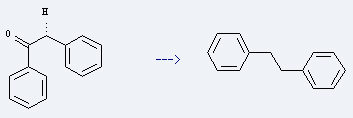-
Name
2-Phenylacetophenone
- EINECS 207-193-2
- CAS No. 451-40-1
- Article Data1117
- CAS DataBase
- Density 1.08 g/cm3
- Solubility Slightly soluble in water
- Melting Point 54-55 °C
- Formula C14H12O
- Boiling Point 320.7 °C at 760 mmHg
- Molecular Weight 196.249
- Flash Point 137 °C
- Transport Information
- Appearance White to off-white crystalline powder
- Safety 22-24/25
- Risk Codes
-
Molecular Structure
- Hazard Symbols
- Synonyms Acetophenone,2-phenyl- (8CI);1,2-Diphenylethan-1-one;1,2-Diphenylethanone;Benzoin, deoxy-;Benzyl phenyl ketone;Deoxybenzoin;Desoxybenzoin;NSC 131456;NSC 249236;NSC 6097;Phenyl benzyl ketone;Phenylmethyl phenyl ketone;a-Phenylacetophenone;
- PSA
- LogP
2-Phenylacetophenone Specification
The Deoxybenzoin with CAS registry number of 451-40-1 is also known as 2-Phenylacetophenone. The systematic name is 1,2-diphenylethanone. It belongs to product categories of Pharmaceutical Intermediates; Aromatic Ketones (substituted). Its EINECS registry number is 207-193-2. In addition, the formula is C14H12O and the molecular weight is 196.24. During using it, do not breathe dust and avoid contact with skin and eyes. Besides, it is a slightly soluble in water and should be sealed in cool and dry place away from oxidizing agents at the temperature of 2-8 °C.
Physical properties about Deoxybenzoin are: (1)ACD/LogP: 3.18; (2)ACD/LogD (pH 5.5): 3.18; (3)ACD/LogD (pH 7.4): 3.18; (4)ACD/BCF (pH 5.5): 153.48; (5)ACD/BCF (pH 7.4): 153.48; (6)ACD/KOC (pH 5.5): 1277.58; (7)ACD/KOC (pH 7.4): 1277.58; (8)#H bond acceptors: 1; (9)#Freely Rotating Bonds: 3; (10)Index of Refraction: 1.583; (11)Molar Refractivity: 60.76 cm3; (12)Molar Volume: 181.6 cm3; (13)Surface Tension: 42.7 dyne/cm; (14)Density: 1.08 g/cm3; (15)Flash Point: 137 °C; (16)Enthalpy of Vaporization: 56.23 kJ/mol; (17)Boiling Point: 320.7 °C at 760 mmHg; (18)Vapour Pressure: 0.000313 mmHg at 25 °C.
Preparation of Deoxybenzoin. Firstly, mixing benzeneacetic acid with phosphorus trichloride to generate phenylacetyl chloride. Then the reaction mixture reacts with benzene in the presence of anhydrous aluminum chloride. At last, collecting fraction at 160 °C to obtain product.
Uses of Deoxybenzoin: it is used to produce 1,2-diphenyl-ethane. The reaction occurs with reagent LiAlH4/P2I4 and solvent benzene with other condition of heating for 6 hours. The yield is about 62%.

You can still convert the following datas into molecular structure:
1. SMILES: O=C(c1ccccc1)Cc2ccccc2
2. InChI: InChI=1/C14H12O/c15-14(13-9-5-2-6-10-13)11-12-7-3-1-4-8-12/h1-10H,11H2
3. InChIKey: OTKCEEWUXHVZQI-UHFFFAOYAG
The toxicity data is as follows:
| Organism | Test Type | Route | Reported Dose (Normalized Dose) | Effect | Source |
|---|---|---|---|---|---|
| mouse | LD50 | intravenous | 320mg/kg (320mg/kg) | U.S. Army Armament Research & Development Command, Chemical Systems Laboratory, NIOSH Exchange Chemicals. Vol. NX#03836, |
Related Products
- 2-Phenylacetophenone
- 4514-53-8
- 451459-17-9
- 451-46-7
- 451492-95-8
- 451493-31-5
- 451494-93-2
- 4515-21-3
- 4515-22-4
- 4515-23-5
- 451524-43-9
Hot Products
About|Contact|Cas|Product Name|Molecular|Country|Encyclopedia
Message|New Cas|MSDS|Service|Advertisement|CAS DataBase|Article Data|Manufacturers | Chemical Catalog
©2008 LookChem.com,License: ICP
NO.:Zhejiang16009103
complaints:service@lookchem.com Desktop View